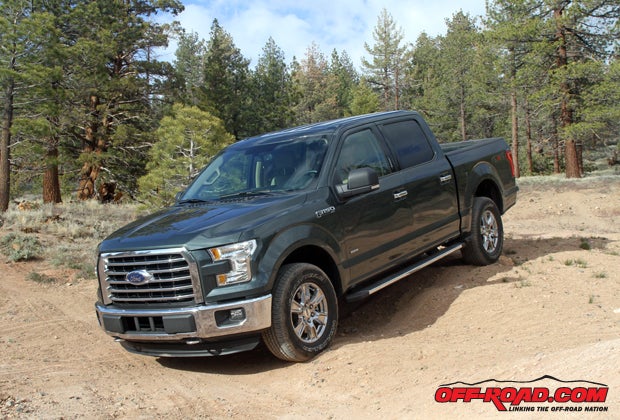
It’s been nearly impossible to miss the arrival of Ford’s newest F-150 in 2015. Even if you’ve “unplugged” from cable TV and avoided social media for the last year or so, chances are you’ve still passed billboards or heard radio commercials hailing the next-generation F-150 pickup that touts a redesigned, lighter aluminum-alloy body and steel frame.
Even though the “lighter” headline gets the most play, the storyline that gets somewhat lost in the shuffle is the F-150’s newest engine: the 2.7-liter EcoBoost V6. Ford made some waves when it removed its beefy 6.2-liter V8 from the 2015 F-150 offerings, which is replaced entirely by its pre-existing 3.5-liter EcoBoost V6 that offers comparable power but an improvement in fuel economy. Ford hasn’t abandoned the V8 entirely however, but playing off of the weight savings it moved to a small 5.0-liter V8 engine. Though the three aforementioned engines are options, the F-150 will come standard with a 3.5-liter naturally aspirated V6.
While each of Ford’s options shows a clear direction to reduce displacement in its truck engines, it’s the 2.7-liter EcoBoost that makes Ford’s boldest proclamation about these beliefs: pairing smaller engines with a lighter chassis is the path to future truck efficiency.
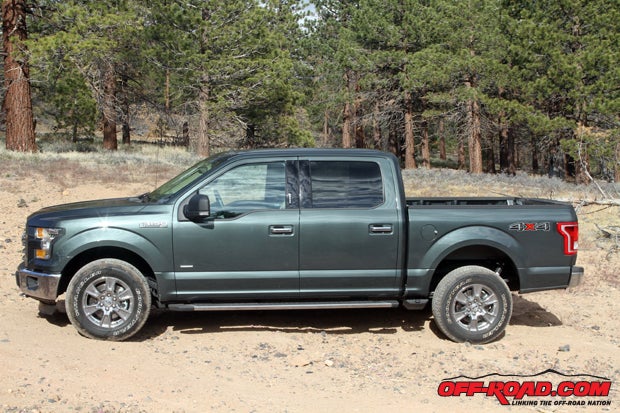
Small But Mighty?
Ford’s notion to place a smaller V6 into its full-size truck is part of a growing trend, and while Ford may not be first to this party, it is unique in the execution of the idea. Parallels can be drawn to Ram’s 3.0-liter EcoDiesel 1500, as both are small V6 motors relying on forced air induction to provide horsepower and torque figures closer in line with V8s. The key difference between these two is that Ford is relying on a twin-turbo gasoline setup, whereas Ram features a supercharged diesel engine. Ultimately both engines reach the destination of providing performance with improved efficiency – they’re just taking different paths to get there.
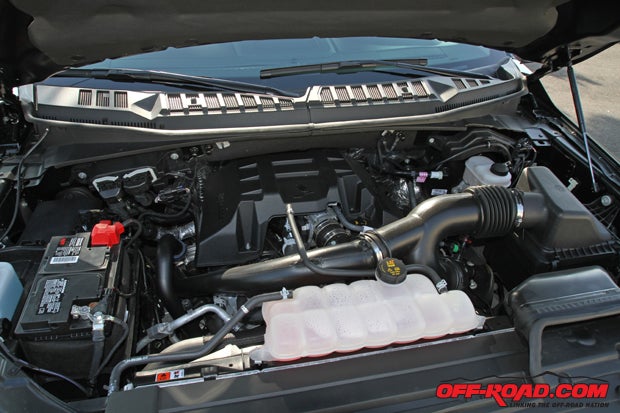
There’s no doubt the 2.7-liter V6 is designed to pack a mean punch, as it is rated to produce 325 horsepower at 5750 rpm and 375 lb.-ft. of torque at 3000 rpm. The impressive output from the 2.7-liter EcoBoost is made possible by producing a tough and durable platform that features the company’s first use of compacted graphite iron (CGI) in a gasoline engine. Previously only found on Power Stroke diesel applications and Ford race motors, the CGI is used for the construction of its upper cylinder block and this stronger material allows engineers to produce a power plant with thinner wall construction and tighter tolerances without sacrificing its durability.
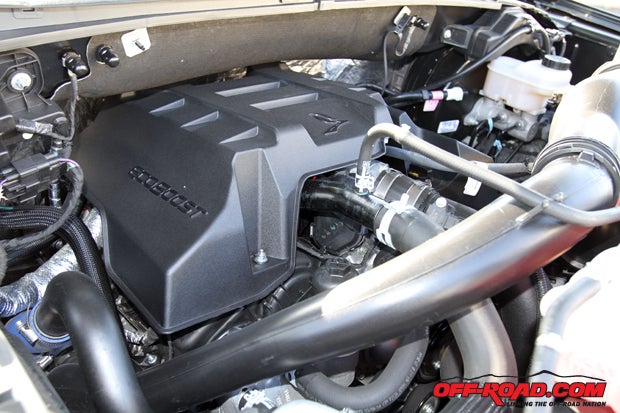
Having spent time in a 3.5-liter EcoBoost F-150 recently during a comparison test with Chevy’s Silverado, we expected a considerable drop-off in performance from the 3.5L to the 2.7L. We’re surprised to say the gap wasn’t as wide as expected, as we were impressed with the performance of the 2.7-liter EcoBoost V6. There are similarities to the motors in seat-of-the-pants feeling: there’s really no “turbo lag” with either EcoBoost motor, as the lack of low-end liveliness prior to getting on boost is simply the lack of displacement showing through. Once on boost, the 2.7L EcoBoost feels strong and offers plenty of power to please most truck owners, and the six-speed automatic transmission clicks through the gears smoothly. Is it as powerful as the 3.5? Definitely not. But one of the truest comments about the 2.7’s performance probably came from our friend, Justin Magner. As the owner of a previous-generation F-150, Justin was solicited for his thoughts regarding the motor. After a few minutes behind the wheel we told him it’s a small dual-turbo V6, to which he responded, “Really? I would’ve thought it was a smaller V8 if you didn’t tell me.”
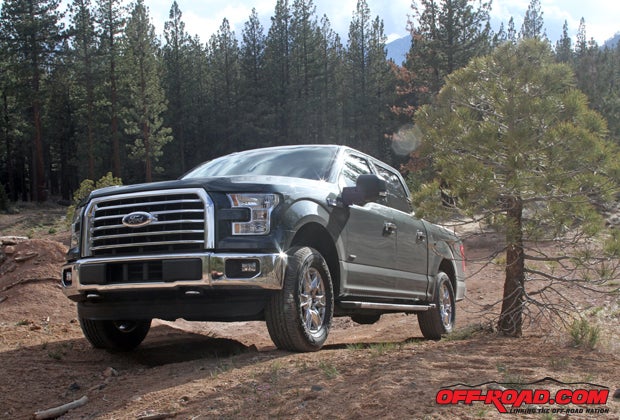
Our 4x4 SuperCrew test truck features settings for Sport Mode and Tow/Haul model. The Sport mode is a nice add-on for drivers who want to feel playful in the truck, but even though the 2.7L provides good all-around performance it definitely doesn’t have the powerful acceleration like the 3.5L. Although we did not get a chance to tow with the truck, the 2.7-liter has a maximum tow rating of 8,500 pounds, though our test truck, fitted with the 3.55 electronic locking rear axle, maxes out at 7,600 pounds.
When we first drove the 2015 F-150 at the press launch in Texas last year, Ford hailed the 2.7 to be its most fuel-efficient motor available on the F-150, but the EPA ratings were not yet available so we didn’t know what those figures were. Now we know the 2.7-liter EcoBoost in a 2WD truck is rated at 19 mpg in the city and 26 mpg on the highway, with a combined rating of 22 mpg. For 4x4s, the EPA ratings are 18 city, 23 highway and 20 combined.
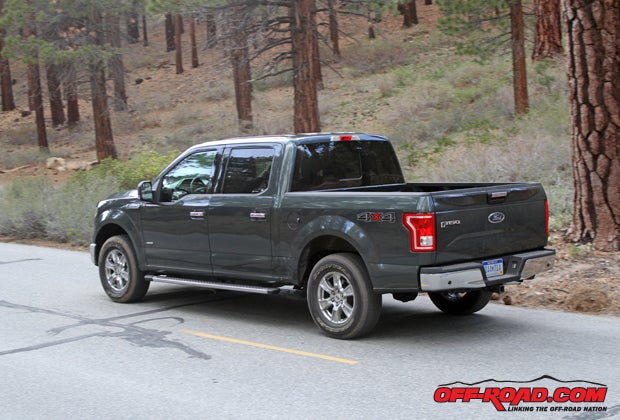
With fuel economy being a big selling point on this truck, we were a little underwhelmed with the numbers we recorded. We drove the truck around town during our test and on local freeways, but we also took an extended road trip up to Mammoth to see the last bit of snow (probably) this season. Our overall combined fuel economy was 19.2, which is in a respectable range of the claimed 20 mpg combined for our 4x4. Where we were a little disappointed with the highway fuel economy; the best fuel economy we attained was 19.8 mpg – we couldn’t get any closer than that to the 23-mpg figure.
Having tested the new 2015 F-150 a few times now, there’s a lot we like about the new truck chassis. The use of aluminum in its body sheds as much as 700 pounds from the 2015 F-150 compared to the previous generation. The decision to use aluminum on the F-150’s body was initially met with skepticism, not because aluminum isn’t used on other automobiles but because it hadn’t been used so predominantly in the truck market. We’ve yet to see a downside to the decision, however, as the reduced weight only aids in the effortless handling of the truck – whether tackling a tight trail, navigating grocery store parking lots, or driving on windy roads.
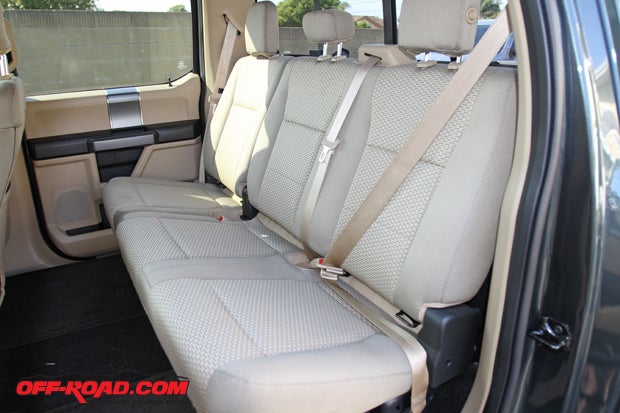
Our XLT SuperCrew 4x4 is equipped with an upgraded 3.55 gear ratio with an electronic rear-locking axle. Although our test truck doesn’t feature the more off-road-savvy FX4 package and the upgraded suspension that comes with it, our 2.7L F-150 was capable and comfortable on the trails. We explored the trails outside of Mammoth Lakes, California, and our truck served as our dirt bike hauler one day to get us up into the mountains to start our ride. On windy country roads the 2.7L F-150 never felt lacking, and in the dirt it was still plenty playful yet composed. When it came to playing in the dirt, the lack of displacement was never anything we missed.
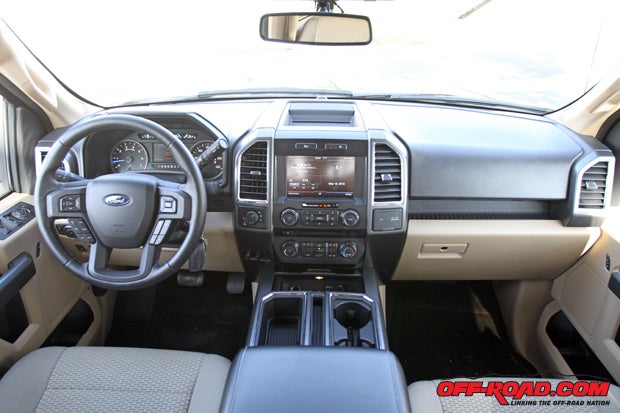
Inside the truck, Ford has added two inches of lateral space for a roomier cabin. There’s definitely plenty of space in our SuperCrew, especially in the spacious backseat that provides 43.6 inches of legroom. The redesigned dash features a nice 8-inch touchscreen front and center to control the Ford Touch and Sync, navigation, stereo, phone settings and more. We like the driver’s instrumentation panel that provides vehicle diagnostics via a centered LED screen (trip meter, fuel economy, tire pressure, etc.) sandwiched between an analog speedo and tachometer, with other analog gauges for fuel, engine temperature and more above. The firm bucket seats are ergonomically comfortable overall, but the firmness had an expiration date in terms of comfort and was not feeling very plush on our longer road trip.
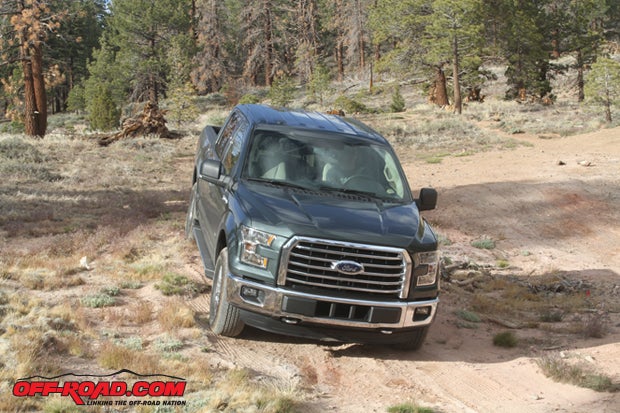
The Future Fulfilled?
At the conclusion of this test, we came away with mixed feelings about Ford’s new engine. In spite of its size, the 2.7L EcoBoost performs well and doesn’t feel underpowered for all things truck. Although it offers the notion of improved efficiency with its small-displacement, turbocharged platform, this is ultimately where the 2.7 falls flat for us. Compared to the naturally aspirated 3.5-liter V6 (282 hp, 253 lb.-ft.) the 2.7 EcoBoost (325 hp, 375 lb.-ft.) offers a notable improvement in performance; that said, they are nearly identical in fuel economy, with a 4x4 2.7 EcoBoost V6 having a 20 mpg combined rating whereas a 4x4 N/A 3.5L V6 is rated at 19 mpg combined. The 2.7 EcoBoost clearly puts out more torque and horsepower, so at $795 more, one could make the argument that the 2.7 EcoBoost V6 offers a reasonable upgrade. We just wish the fuel economy was better – or at least hit the claimed numbers.
If it were our money, we’d probably spend the extra dough to upgrade to the 3.5-liter EcoBoost V6, which is $1995 more than the base N/A V6, as it offers the best overall performance of the four engines (365 hp, 420 lb.-ft.) and has a combined fuel economy rating of 19 mpg in a 4x4 setup. The 2.7 EcoBoost is an interesting proposition, and for some it might be the right choice. But for us, it simply doesn’t deliver enough fuel efficiency to make it worthwhile.
MORE 2015 FORD F-150
2015 Ford F-150 3.5L EcoBoost vs. 6.2L Chevy Silverado
First Drive: 2015 Ford F-150 Unveil in Texas
Specifications – 2015 Ford F-150 Supercrew 2.7L EcoBoost 4x4Engine: 2.7-liter EcoBoost V6
Horsepower: 325 hp @ 5,750 rpm
Torque: 375 lb.-ft. @ 3,000 rpm
Transmission: Electronic 6-speed automatic
Height: 77.2 in.
Track Width: 67.6 in. (front & rear)
Length: 231.9 in.
Wheelbase: 145 in.
Approach Angle: 25.5 degrees
Departure Angle: 26.0 degrees
Breakover Angle: 21.0 degrees
Ground Clearance (suspension or axle to ground): 9.4 in.
Claimed Curb Weight: 4,806 lbs.
Gross Vehicle Weight Rating: 6,500 lbs.
Towing Capacity: 7,600 lbs.
Payload Capacity: 1,640 lbs.
Fuel Tank: 23 gal.
Seating Capacity: 5
Axle Ratio: 3.55
Aver. MPG (tested): 19.2 mpg overall
Price: $46,500*
*Sticker price as tested, includes destination charges


 Your Privacy Choices
Your Privacy Choices